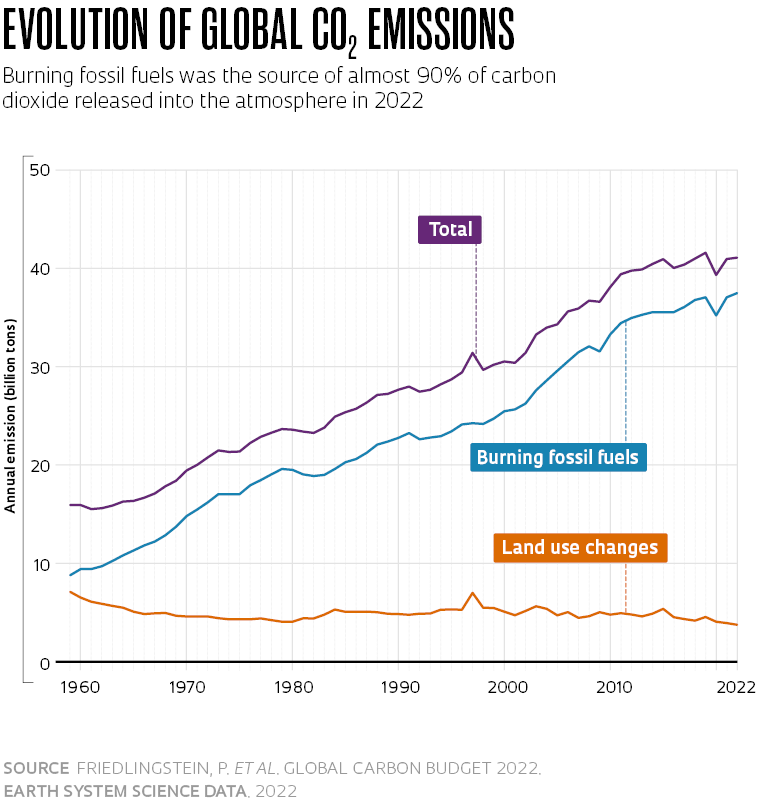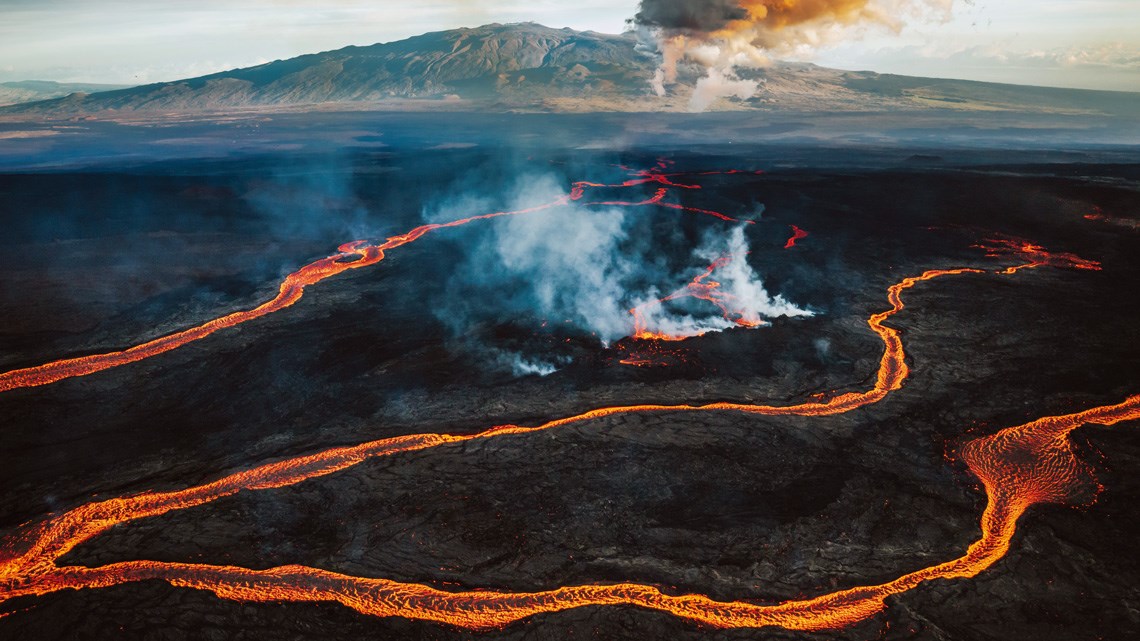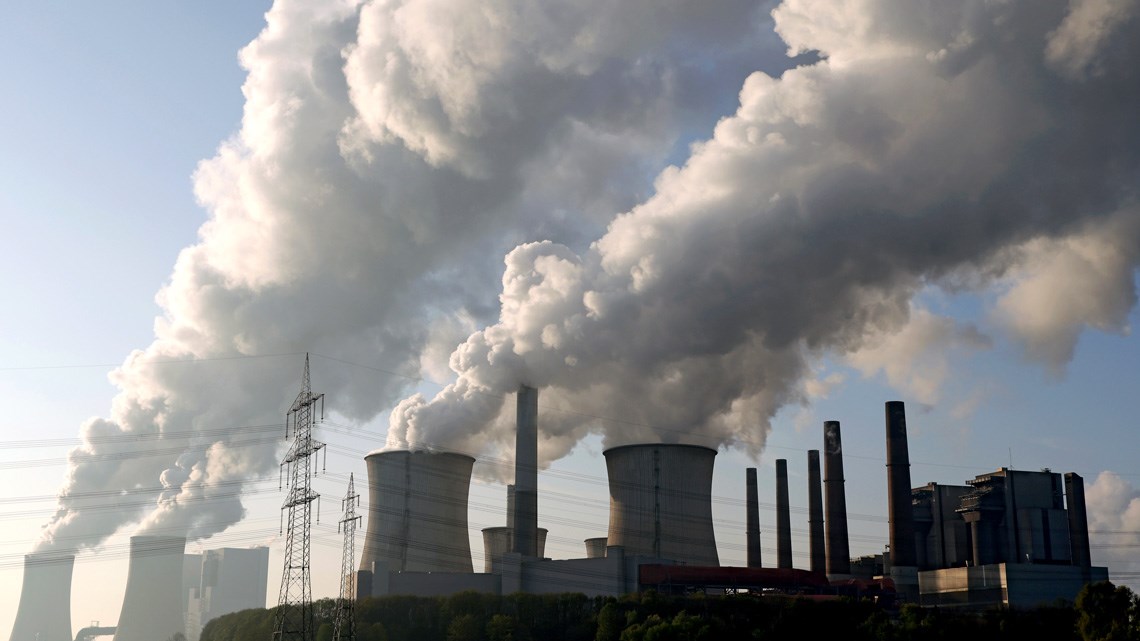Nine years. That is when it is estimated that the average temperature of Earth’s atmosphere will reach 1.5 degrees Celsius (ºC) warmer than it was in the mid-nineteenth century, the point of reference used to calculate global warming, which is causing climate crises all over the world. The prediction has a 50% chance of coming true if global carbon dioxide (CO2) emissions remain at 2022 levels, according to a study published in the scientific journal Earth System Science Data in November by the international group of scientists that run the Global Carbon Project. Created in 2001, the organization releases updated CO2 emission and absorption projections every year, as well as for other greenhouse gases (GHGs), such as methane (CH4) and nitrous oxide (N2O). The article predicts that if current trends continue, the planet’s temperature will rise by 1.7 ºC in the next 18 years and 2 ºC within 30.
Now that the most acute phase of the pandemic has been overcome, the global situation is not significantly different to the pre-COVID-19 world. The data for the first year in which the health emergency remained relatively under control and the world economy began functioning with almost no restrictions are not encouraging. Global CO2 emissions reached 40.6 billion tons in 2022—almost equal to the record amount recorded in 2019, the year before the SARS-CoV-2 virus emerged, when 40.9 billion tons of carbon dioxide were released into the atmosphere.
According to the study, around 36.6 billion tons of CO2 emissions were caused by burning fossil fuels (oil, gas, and coal) in 2022, an increase of 1% over the previous year. This amount represents almost 89% of all carbon dioxide released by human activity on the planet. The remaining 11% came from changes in land use, especially the removal of forests and other native vegetation (which if preserved, generally capture more CO2 than they release) to make way for agricultural activities, which tend to produce more greenhouse gases.
“This year we see yet another rise in global fossil carbon dioxide emissions, when we need a rapid decline,” French climate scientist Pierre Friedlingstein of the University of Exeter, UK, lead author of the article, said in a press release. “There are some positive signs, but global leaders will have to take meaningful action if we are to have any chance of limiting global warming close to 1.5 °C.” It is true that the situation has been worse in the past. At the turn of the century, CO2 emissions from fossil fuel burning were growing at an annual rate of 3%. In the last decade, however, they have increased by around 0.5% per year. This is progress, but not enough to stop the planet’s average temperature from rising.
The Paris Agreement, an international treaty on climate change, was signed at a UN meeting in December 2015 by 195 countries, including Brazil, with the target of limiting global warming to less than 2 ºC above preindustrial temperatures. Ideally, the temperature should not increase by more than 1.5 ºC, a level considered high, but with potentially manageable socioeconomic impacts.
Based on the current rate of emissions, this goal will be all but impossible to achieve. The Earth’s temperature is currently about 1.2 °C warmer than it was in the mid-nineteenth century. The atmospheric CO2 concentration is now 417 parts per million (ppm), about 50% higher than in the 1850s. The Mauna Loa Observatory in Hawaii, which has been the most reputable source of data on CO2 concentrations since the 1960s, had to temporarily shut down at the end of November due to a volcanic eruption (see box below).

The most recent study by the Global Carbon Project, which comprises some 100 scientists, listed the countries that release the most carbon dioxide into the atmosphere. China alone currently accounts for 31% of emissions from fossil fuel burning, just over double the USA in second place. India, whose emissions grew by 6% in 2022, has surpassed the European Union and is now the country that emits the third most CO2 into the air. It is responsible for releasing almost 8% of all carbon dioxide from fossil fuels. When it comes to the cumulative amount of carbon dioxide released into the atmosphere, the US and the EU have historically been at the top of the list, well above the current major economies in Asia.
The study does not specify Brazil’s exact placement among the world’s biggest generators of CO2. Usually, however, the country is in the top five or 10. The article does point out that Brazil, Indonesia, and the Democratic Republic of Congo together accounted for 58% of carbon dioxide emissions linked to land use changes in 2022. These three nations are home to vast rainforests in South America, Asia, and Africa respectively, which are often subject to deforestation.
“Brazil’s greenhouse gas emissions profile is different to richer countries, where almost 90% comes from burning fossil fuels,” explains Ane Alencar, director of science at the Amazon Environmental Research Institute (IPAM), a nongovernmental organization (NGO) dedicated to studying sustainable development of the biome.
According to data published last November by the Climate Observatory’s Greenhouse Gas Emission and Removal Estimating System (SEEG), about half of Brazilian GHG emissions result from deforestation (changes in land use) and a quarter from agricultural activities. “Here, land use changes represent a much greater proportion of our emissions,” says Alencar, who heads the sector within SEEG. The remainder comes from industrial activities, energy production, and waste management.
The Climate Observatory is an NGO that unites universities, tech companies, and civil organizations in Brazil (such as IPAM). It created the SEEG system in 2013 as a complement to the country’s official data on greenhouse gas emissions. Unlike the international survey by the Global Carbon Project, which looked specifically at CO2, the SEEG report covers all gases that contribute to global warming. In 2021, total greenhouse gas emission in Brazil, considering all sources, was 2.4 billion tons, an increase of 12% over 2020, according to SEEG. After discounting carbon absorbed on national soil—primarily through photosynthesis by plants, which consume CO2 from the atmosphere—the carbon balance drops to an emission surplus of 1.8 billion tons.
The country’s sixth official annual GHG emissions estimate, released in June 2022 by the Ministry of Science, Technology, and Innovation (MCTI), presents a similar figure: net emissions (disregarding absorptions) of 1.7 billion tons of CO2 in 2020. “The SEEG methodology is based on the annual inventory of GHG emissions and obtained similar results to ours,” says Márcio Rojas, general coordinator of climate science and sustainability at MCTI.
Marcos Heil Costa, a climatologist from the Federal University of Viçosa (UFV) who studies the interactions between climate and agriculture, believes the emissions profile in Brazil, where CO2 production is more heavily associated with land use changes, could represent an advantage if approached correctly. “We showed that in just seven years between 2005 and 2012, when deforestation in the Amazon fell considerably, we were able to reduce emissions associated with deforestation by 85%,” points out Costa, one of the Brazilian authors of the latest report by the Intergovernmental Panel on Climate Change (IPCC). “We could achieve similar or even greater results by the end of this decade.” On the other hand, says the climatologist, countries whose emissions are dominated by fossil fuel burning would need to change their energy mix in order to achieve significant results. This is a process that can take decades.
Lava from Hawaii’s Mauna Loa volcano cuts power and road access to renowned observatory
Considered the largest active volcano on Earth, Mauna Loa, part of the Hawaiian archipelago in the North Pacific, had been quiet for 38 years before the crater at its peak, located about 4,200 meters above sea level, began to expel lava on November 27. The volcano had been showing signs that it would soon erupt since September. Mauna Loa is one of the volcanoes most widely studied by the scientific community and the eruption, although strong, caught nobody off guard and did not cause any human casualties. It did, however, manage to block the road leading to the Mauna Loa Observatory and cut off the electricity on November 29.

Carly Menker / NOAANOAA observatory on the Hawaiian islandCarly Menker / NOAA
The observatory, currently operated by the US National Oceanic and Atmospheric Administration (NOAA), has been responsible for recording the daily concentration of carbon dioxide (CO2) in the Earth’s atmosphere since 1958. Its measurements are often used as a reference in climate studies. The data is represented as a Keeling Curve, named after American geochemist Charles Keeling (1928–2005), who was the first to document the rising atmospheric levels of CO2 based on measurements taken on the North-Pacific island.

Andrew Richard Hara / Getty ImagesMauna Loa volcano in Hawaii, active in November 2022Andrew Richard Hara / Getty Images
Due to its remote location, Mauna Loa’s air is very clean, subject to minimal influence from human activities and emissions from vegetation. This makes it an ideal place to monitor the composition of the atmosphere over the long term. Similar data is collected elsewhere around the planet, including at the South Pole, but data from Hawaii are the internationally adopted benchmark. As of December 19, the measurements are yet to be resumed, although volcanologists have evidence that the volcano’s activity appears to have ended on December 13.
Scientific article
FRIEDLINGSTEIN, P. et al. Global carbon budget 2022. Earth System Science Data. vol. 14, no. 11. nov. 11, 2022.


